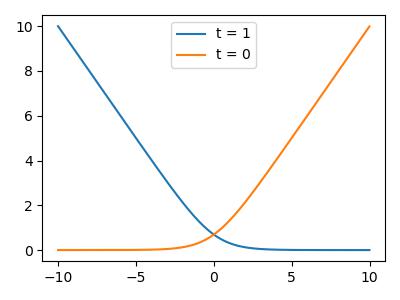Classification Optimization
Binary Linear Classification
Let the target \(t \in \{0,1\}\) be the binary classification, using a linear function model \(z = \vec w^T \vec x\) with threshold \(I(z \geq 0)\)
where \(\vec x\) is the training data with one more dummy variable \(1\) so that the threshold is always \(0\)
Geometric Picture
Given input \(t = \text{NOT } x, x\in\{0,1\}\)
Input space
the weights (hypothesis) can be represented by half-spaces
The boundary is the decision boundary \(\{\vec x\mid \vec w^T \vec x = 0\}\)
If the training example can be perfectly separated by a linear decision rule, we say the data is linearly separable
weight space
each training example \(\vec x\) specifies a half space \(\vec w\) must lie in to be correctly classified: \(w^Tx >0\) if \(t = 1\) The region satisfying all the constraints is the feasible region. The problem is feasible is the region \(\neq \emptyset\), otw infeasible
Note that if training set is separable, we can solve \(\vec w\) using linear programming
Loss Function
0-1 Loss
Define the 0-1 Loss be
Then, the cost is
However, such loss is hard to optimize (NP-hard considering integer programming)
Note that \(\partial_{w_j} \mathcal L_{0-1} = 0\) almost everywhere (since \(\mathcal L\) is a step function w.r.t \(z\))
Surrogate loss function
If we treat the model as a linear regression model, then
However, the loss function will give large loss if the prediction is correct with high confidence.
Logistic Activation Function
Using logistic function \(\sigma(z) = (1+e^{-z})^{-1}\) to transform \(z = \vec w^T\vec x + b\).
A linear model with a logistic nonlinearity is known as log-linear
In this way, \(\sigma\) is called an activation function
However, for \(z\rightarrow \pm\infty, \sigma(z)\approx 0\) If the prediction is really wrong, you should be far from a critical point
Cross-entropy loss (log loss)
More loss if the prediction is "more" confident about "wrong" answers and not punishing the correct one even not confident
where \(t\in\{0,1\}\)
Logistic Regression
\(z = \vec w^T \vec x+b\)
\(y = \sigma(z) = (1+\exp(-z))^{-1}\)
\(\mathcal L_{CE}(y,t) = -t\log(y) - (1-t)\log(1-y)\)
Gradient Descent
Initialize the weights to something reasonable and repeated adjust them in the direction of steepest descent
\(\alpha \in (0, 1]\) is the learning rate (step size)
When \(J\) converges, \(\partial_{\vec w} J = 0\) at the critical point
Under L2 Regularization
The gradient descent update to minimize the regularized cost \(\mathcal J + \lambda \mathcal R\) results in weight decay
Learning rate
In gradient descent, the learning rate \(\alpha\) is a hyper parameter. (TUT3)
Training Curves
To diagnose optimization problems, plot the training cost as a function of iteration.
However, it's very hard to tell whether an optimizer has converged.
Example: Gradient of logistic loss
Multiclass Classification (Softmax Regression)
One-hot vector/ one-of-K encoding Target
Targets from a discrete set \(\{1,...,K\}\)
For convenience, let \(t\in\mathbb R^K, t_i= \mathbb I(i=k)\) where \(k\) is the classification.
Linear predictions
\(D\) input, \(K\) output, hence we need a weight matrix \(W\)
Otherwise \(Z= Wx^*\) where \(x^*\) is \(x\) padded a column of \(1\)'s.
Softmax Function Activation
A generalization of the logistic function
The input \(z_k\) are the logits
Properties
- Outputs are positive and sum to \(1, (\sum_k y_k = 1)\) so that can be interpreted as probabilities
- If one of \(z_k\) is much larger, than \(softmax(z)_k \approx 1\)
Cross Entropy Loss
Use cross-entropy as the loss function, as from logistic regression
Log is applied element-wise
Gradient descent
Updates can be derived for each row of \(W\)
Source code
import matplotlib.pyplot as plt
import numpy as np
z = np.arange(-10, 10, 0.01)
loss = (np.exp(-z) + 1) ** -1
plt.figure(figsize=(4, 3))
plt.plot(z, loss)
plt.title("logistic function")
plt.tight_layout()
plt.savefig("../assets/classification_logistic.jpg")
plt.figure(figsize=(4, 3))
plt.plot(z, -1 * np.log(loss), label="t = 1")
plt.plot(z, -1 * np.log(1 - loss), label="t = 0")
plt.legend()
plt.tight_layout()
plt.savefig("../assets/classification_loss.jpg")

